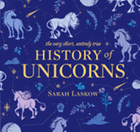
No matter how readers picture unicorns--majestic, pure white, horse-like creatures or cartoon characters sporting manes streaked with all the colors of the rainbow--when they open the pages of this inviting compendium they'll find plenty of fascinating, fun facts about the ever-popular magical creatures.
A Greek doctor living in Persia "more than 2300 years ago" wrote about "the existence of fantastic one-horned 'wild asses' " whose "bodies are white, their heads dark red, and their eyes dark blue." In the centuries that followed, one-horned beasts were said to resemble goats, deer and bulls. The horns themselves were reported to vary from "a foot and a half in length," to three feet, to "four feet long and spiral," until finally, "by the 1200s, some writers thought the unicorn's horn was ten feet long!"
Sarah Laskow's text provides a fine collection of information about the history of human fascination with the unicorn. A limited number of period drawings, tapestries and coins are heavily supplemented with comics artist Sam Beck's illustrations. The material brings the creature into modern times with the inclusion of more recent oddities such as Lancelot the "Living Unicorn" (which traveled with the Ringling Bros. and Barnum & Bailey circus in the late 1980s) as well as a concise survey of 21st-century cartoons, video games, emojis and memes based on the mythical beast. Foods, too, have been affected by the popularity of unicorns--Laskow even includes a recipe for "Unicorn Poop Bark." Overflowing with evidence that "people have been talking and thinking about unicorns for thousands of years," The Very Short, Entirely True History of Unicorns suggests there is every reason to expect the fascination will continue. --Lynn Becker, blogger and host of Book Talk, a monthly online discussion of children's books for SCBWI

